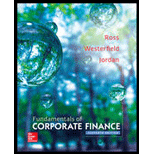
Concept explainers
Chase Bank pays an annual dividend of $1.05 per share on its common stock. One year ago, this stock sold for $48 per share. Today, the stock is priced to sell at $31 per share. What is the
To determine: The capital gains yield.
Introduction:
Total return refers to the total income from an investment. The total income includes the periodic incomes and the increase or decrease in the value of an asset.
Capital yield refers to the change in the value of investment stated in terms of percentage.
Answer to Problem 12.1CTF
The capital gains yield is (35.42 percent). The yield is negative because of the decrease in the value of the investment.
Explanation of Solution
Given information:
The stock price of Bank C one year ago was $48. The bank paid $1.05 per share as dividend for the year. The current price of the stock in the market is $31.
The formula to calculate the capital gains yield:
Where,
“Pt+1” refers to the price at the end of the year
“Pt” refers to the initial price of the share
Compute the capital gains yield:
Hence, the capital gains yield is (35.42 percent).
Want to see more full solutions like this?
Chapter 12 Solutions
Fundamentals of Corporate Finance
 EBK CONTEMPORARY FINANCIAL MANAGEMENTFinanceISBN:9781337514835Author:MOYERPublisher:CENGAGE LEARNING - CONSIGNMENT
EBK CONTEMPORARY FINANCIAL MANAGEMENTFinanceISBN:9781337514835Author:MOYERPublisher:CENGAGE LEARNING - CONSIGNMENT Intermediate Financial Management (MindTap Course...FinanceISBN:9781337395083Author:Eugene F. Brigham, Phillip R. DavesPublisher:Cengage Learning
Intermediate Financial Management (MindTap Course...FinanceISBN:9781337395083Author:Eugene F. Brigham, Phillip R. DavesPublisher:Cengage Learning


